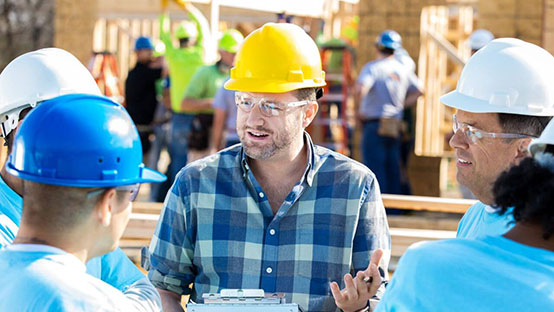Construction drawings? Check. Contractors hired? Check. Construction checklist? Not checked yet, but it’s about to be. The team at Cedreo has put together this quick guide to everything you need to know about pre-construction checklists, construction checklists and related items. Read on to learn more about this essential subject.
What Is a Construction Checklist?
A construction checklist is pretty much what it sounds like: It’s a list of tasks or items that someone in charge of a particular phase of construction must delegate or complete.
You might hear these checklists called construction scope of work checklists, pre-construction checklists, new home construction checklists or other names. Each name suggests a slightly different set of tasks and items, and each is critically important to the successful completion of one or multiple phases of a construction project.
Why Are Construction Checklists Important?
Construction is complicated. At any given moment in the construction process, there are dozens of considerations that someone has to keep in mind. Miss one tiny detail, and the entire project can be delayed or derailed.
Construction checklists help crews and construction managers avoid those kinds of problems. By listing all of the hundreds of possible tasks in one central place, a checklist helps you keep track of your to-dos in an effective and simple way.
If everything on the list is checked at the end of the phase or project, you should be in good shape. And in home construction, being in good shape throughout every project is essential.
Who Uses Construction Checklists?
Nearly anyone involved in construction at any phase can use their own checklist to remember various activities for which they are responsible. But those who use formalized new home construction checklists are typically those in charge of the project or a particular team.
For example, construction supervisors, contractors, construction site owners and even construction inspectors may rely on a checklist to keep track of all of the tasks for which they or their teams are responsible.
What Are the Most Common Use Cases for Construction Checklists?
While many people involved in the design and construction processes may use construction checklists, you are most likely to find them involved in a particular set of processes or concerns. Here is a list of some of the most common use cases for checklists in construction:
- Assessing risks. A particular set of tasks for a site inspector or manager may fit nicely into a checklist meant to assess the potential for risk on any construction process. That risk may involve the risk of employee injury, the risk of lost investment capital or the risk of project delays that leave clients upset.
- Promoting safety. Pre-construction checklists often focus heavily on the worker safety aspect of construction. This is a dangerous industry, after all, and it can be tough to remember the hundreds of individual safety measures that must be in place before a crew can safely begin work.
- Equipment maintenance and repair. Longer-term checklists may contain tasks for inspections of commonly used tools and equipment. For equipment that will require routine repairs or updates, a maintenance checklist can keep the whole team on the same page.
- Materials. A construction scope of work checklist may contain a rough list of the materials — types, amounts and other specs — for a given project.
- Client updates. An internal construction checklist may inform project leads on which points in time they need to reach out to the client to provide status updates.
- New employees. An in-depth checklist can be an invaluable resource to give to any new employee at a construction company.
- The complete checklist. A master checklist can serve as the final word on any construction project. If it’s not in the master list, it doesn’t get done, and the project isn’t done until every item in the master checklist is completed.


What Are the Most Common Types of Construction Checklists?
In the construction industry, there are a few established types of construction checklists that you’re likely to come across. Although you can create a checklist for just about any construction phase or task, these are the most common types:
Safety
Safety checklists can focus on a wide range of aspects related to safety at construction sites. For example, one checklist may detail every task needed to ensure fire safety at the construction site, while another may focus solely on risk assessment and hazard mitigation. Additionally, pre-construction safety checklists may examine various aspects of the site before work begins, and electrical safety checklists may take an in-depth look at this crucial aspect of the final construction.
Equipment
The equipment involved in construction is not only expensive, it’s dangerous — particularly when people aren’t equipped with the information they need to operate the equipment safely. This is precisely the purpose of an equipment safety checklist. These checklists may focus on a particular type of equipment, such as hand tools, fall prevention or personal protective equipment (PPE).
Emergencies
For some construction checklists, the hope is that you don’t have to use them. That’s certainly the case with emergency construction checklists. These are lists of tasks that kick in when something goes wrong or some kind of emergency occurs. Emergencies for which you may want to have a checklist in place include illnesses, injuries and property damage. Related checklists include fire safety checklists and first aid checklists to ensure you have the proper equipment on hand in the event of an emergency.
Certifications
If you have employees at a worksite without the proper certifications, accidents and injuries are more likely. And that doesn’t even touch on the reduction in construction quality that occurs when workers are not properly trained. A certifications construction checklist can help with this exact issue. For example, you may assess your quality assurance system by building a checklist based on industry-standard ISO 9001 certification.
Quality
You need several quality checklists — one for each separate aspect of the final product you are constructing. This means you may have separate checklists for drainage systems, earthworks, concrete work, demolition, grubbing, slipforming, reinforcement, window frames, roofs, ceilings, walls, doors, floors and many more factors.
Pre-work
Any checklist that must be completed before work can begin is a pre-work construction checklist. However, these checklists tend to focus on tasks like sourcing materials, completing floor plans, client approvals, contractor selection and similar items.
Tips for Creating a Construction Checklist
While it’s not hard to understand how useful a construction checklist can be, it can be hard to come up with one that really works for your company. But these tips should help.
Review examples
Many construction companies and blogs have published their checklists for various processes online as part of their marketing strategies. This is something you can and should take advantage of. Review as many construction checklist examples as you can find, and don’t just look for the ones that would be perfect for your business. Even checklists that would never work for your needs can help you understand what not to include in your final checklists.
Use a template
Construction checklist templates do exist, and many of them are free to download and use. These templates can give you an enormously helpful starting point for your checklists, and they will often fill in gaps you might have left if you had started from scratch. However, it’s important to note that your checklists should be tailored to your company’s unique needs and processes. So, if you use a template, treat it as a starting point rather than the final product.
Customize it to meet your needs
Run through the template you have selected, applying each step to your processes as they currently stand. Write down everything that is missing from the template. When you’re done, go back and add all the missing pieces to the appropriate places in the template. That’s how you customize your construction checklists to truly work for you.
Make it digital
In this day and age, everything is digital. That should include any and all checklists for your construction processes. Why? Because paper copies are great, but they can cause problems. You might misread someone’s handwriting or even lose the hard copy and have no idea what has and has not been completed. With digital checklists, you don’t have to worry about issues like that.
Ensure checklist items are up to date
Set a schedule for updating your construction checklist. If you think about it, you’ll realize that your processes routinely experience small adjustments. Each time there’s a change, your checklists need to reflect it or else you risk losing it in the confusion.
What to Include in a Construction Checklist
Ready to start creating construction scope of work checklists, pre-construction checklists and more for your company? Make sure you include the following items:
- Success metrics. What does success look like for each item in your checklist? Make sure that is clearly defined in the documentation surrounding all of these processes.
- Detailed budget. One of the biggest checklist items that routinely gets left off of checklists for construction is the budget. Supervisors need to know what they’re working with in terms of budget as they complete any given checklist. Make sure that information is readily available.
- Work structure breakdown. Who is responsible for which tasks? There should never be confusion on this point around a construction site, and your checklists can ensure that there never is.
- Schedules. A checklist without due dates isn’t very compelling. You need to put deadlines on every task and subtask to ensure that everything stays on schedule.
- Communication plans. Define in each checklist who needs to know when it is completed or when there are problems or delays.
- Procurement plans. For many checklists, information about where materials or equipment will come from will be highly relevant to the supervisor overseeing the work. Make sure they don’t have to go searching for this need-to-know information. Put it right in the checklist.
- Site safety plans. Safety is everything in construction. So, if a checklist mentions any tasks that could pose any sort of danger to an employee, it also needs to point to a particular safety plan or reference.
Wrap Up
Construction checklists set you up for success over the long term. Without checklists, mistakes are bound to happen. Construction is complicated, and you need a system to make sure your quality doesn’t suffer.
Cedreo does the same thing as checklists for home builders but in a slightly different way. Our detailed 2D and 3D floor planning software provides a framework in which you can quickly create fully furnished home designs in 2D and 3D. Each step of the process is clearly defined and easy to understand. That way, you never miss anything, and your business grows.



